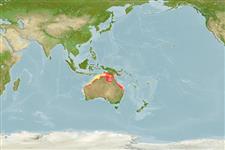Mammalia |
Cetartiodactyla |
Delphinidae
Environment: milieu / climate zone / Mức độ sâu / distribution range
Sinh thái học
Tầng nổi; Mức độ sâu 0 - 200 m, usually 1 - 10 m. Tropical; 7°S - 90°S, 100°E - 180°E
Indo-Pacific: Australia and Papua New Guinea.
Length at first maturity / Bộ gần gũi / Weight / Age
Chín muồi sinh dục: Lm ? range ? - ? cm Max length : 270 cm TL con đực/không giới tính; (Tài liệu tham khảo 78832); 230 cm TL (female)
In lateral view the head is rounded and usually bounded by a distinct neck crease, lacking dorsal groove; mesethmoid plate reduced and generally in advance of the anterior most nasal ossicle, exposing a large area of the frontal bone; presence of supernumerary bone between nasal ossicles and posterior border of mesethmoid; has a greater length of the antiorbital process and a more closely opposed pterygoid hamuli with medial flanges.
Occurs in protected, shallow, coastal waters especially adjacent to river and creek mouths (Ref. 79537).
Life cycle and mating behavior
Chín muồi sinh dục | Sự tái sinh sản | Đẻ trứng | Eggs | Sự sinh sản | Larvae
Beasley, I., K.M. Robertson and P. Arnold 2005 Description of a new dolphin, the Australian snubfin dolphin Orcaella heinsohni sp. n. (Cetacea, Delphinidae). Marine Mammal Science 21(3):365-400. (Tài liệu tham khảo 78832)
IUCN Red List Status
(Tài liệu tham khảo 130435: Version 2025-1)
CITES status (Tài liệu tham khảo 108899)
CMS (Tài liệu tham khảo 116361)
Threat to humans
Harmless
Human uses
FAO - Các nghề cá: landings | FishSource |
Các công cụ
Thêm thông tin
Sinh thái dinh dưỡngFood items (preys)
Thành phần thức ăn
Thành phần thức ăn
Các động vật ăn mồi
Population dynamicsSự sinh trưởngMax. ages / sizesLength-weight rel.Length-length rel.Length-frequenciesMass conversionSự phong phú Life cycleSự tái sinh sản
Chín muồi sinh dục
Sự sinh sản
Đẻ trứng
Eggs
Egg development
Larvae
PhysiologyThành phần ô-xy
Human RelatedStamps, coins, misc.
Các nguồn internet
Estimates based on models
Preferred temperature
(Ref.
115969): 26.9 - 28.8, mean 28 (based on 452 cells).
Fishing Vulnerability
Very high vulnerability (90 of 100).
